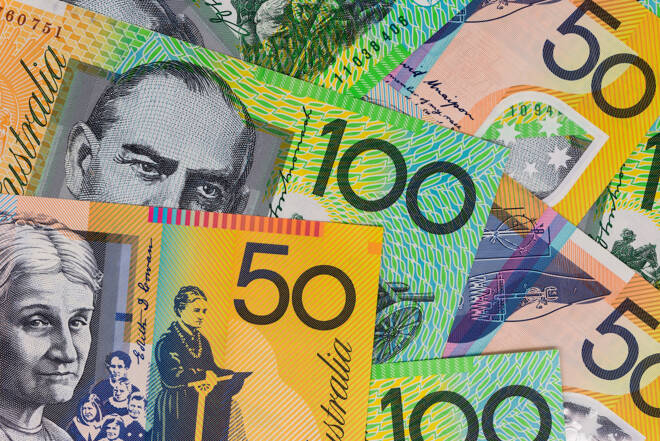Advertisement
Advertisement
AUD to USD Forecast: Economic Uncertainty Shadows Aussie’s Rise
By:
The Aussie dollar navigates through uncertainties as Australian housing credit and US economic indicators shape forecasts, hinting at potential market shifts.
Highlights
- The AUD/USD saw a 1.17% surge on Thursday, reversing a prior 0.70% loss.
- Market focus shifts to Australian housing credit with forecasts suggesting a steady 0.3% rise in August.
- The US Personal Income & Outlays Report is eyed for clues on a possible December Fed rate hike.
Thursday Overview
On Thursday, the AUD/USD surged by 1.17%. Reversing a 0.70% loss from Wednesday, the Aussie dollar ended the day at $0.64264. The Aussie dollar fell to a low of $0.63447 before reaching a high of $0.64325.
Australian Housing Credit and the Housing Sector in Focus
After the Thursday bounce, the market focus will turn to Australian housing credit numbers. Economists forecast housing credit to increase by 0.3% in August, the same rate as in July.
Economic uncertainty from China remains a headwind. However, the RBA moves to tame inflation have negatively impacted the Australian real estate sector.
The elevated inflation environment impacts borrowing costs. Higher mortgage repayments reduce disposable income and adversely affect consumer spending. A deteriorating housing market could add further pressure on homeowners and consumer confidence.
While the housing sector contributes 5% to GDP, Australian private consumption accounts for 50% of the Australian economy. Weaker housing credit figures may signal a deterioration in housing market conditions that could impact consumption and the economy.
US Personal Income & Outlays Report in Focus
Later today, US economic indicators may fuel bets on a December Fed rate hike. The US Personal Income & Outlays Report will garner interest.
While personal income is a material consideration for inflation, the Core PCE Price Index may have more influence on the US dollar. Sticky inflation will likely pressure the Fed to pursue a hawkish rate path to tame inflation.
However, personal spending also needs consideration. Higher personal spending will likely fuel demand-driven inflationary pressures, supporting the more hawkish Fed rate path.
Higher interest rates impact labor market conditions and borrowing costs, weighing on disposable income. A downward trend in disposable income forces consumers to curb spending, which eases demand-driven inflationary pressures.
Economists forecast the Core PCE Price Index to rise by 3.9% year-over-year in August versus 4.2% in July. Economists predict personal income to increase by 0.4% and personal spending to rise by 0.4%. Hotter-than-expected inflation and consumption figures would drive demand for the greenback.
Short-Term Forecast
The AUD/USD remains in a bearish trend despite the Thursday bounce. After a 3.46% tumble in August, the Aussie dollar is down 0.84% in September. However, softer US inflation numbers and a pullback in spending could ease pressure on the Fed to maintain a hawkish rate path.
AUD/USD Price Action
Daily Chart
The AUD/USD remained below the 50-day and 200-day EMAs, affirming bearish price signals.
An AUD/USD break below the $0.63854 support level would bring the trend line into play. Better-than-expected US inflation numbers and weaker Australian housing sector credit could support a pullback.
Softer US inflation and personal spending numbers would support an AUD/USD move to the 50-day EMA and the $0.64900 resistance level. Selling pressure may intensify in the $0.64830 – $0.64900 range. The 50-day EMA is confluent with the $0.64900 resistance level.
A 14-period Daily RSI reading of 47.98 supports an AUD/USD break below the trend line before entering oversold territory (typically below 30 on the RSI scale).
4-Hourly Chart
The AUD/USD hovers above the 50-day EMA while sitting below the 200-day EMAs, sending bullish near-term but bearish longer-term price signals.
A hold above the 50-day EMA may support a break above the 200-day EMA to target the $0.64900 resistance level.
However, a fall through the 50-day EMA would support a move to the $0.63854 support level.
The 14-period 4-Hourly RSI at 58.66 supports an AUD/USD break above the 200-day EMA before entering overbought territory (typically above 70 on the RSI scale)
About the Author
Bob Masonauthor
With over 28 years of experience in the financial industry, Bob has worked with various global rating agencies and multinational banks. Currently he is covering currencies, commodities, alternative asset classes and global equities, focusing mostly on European and Asian markets.
Did you find this article useful?
Latest news and analysis
Advertisement
